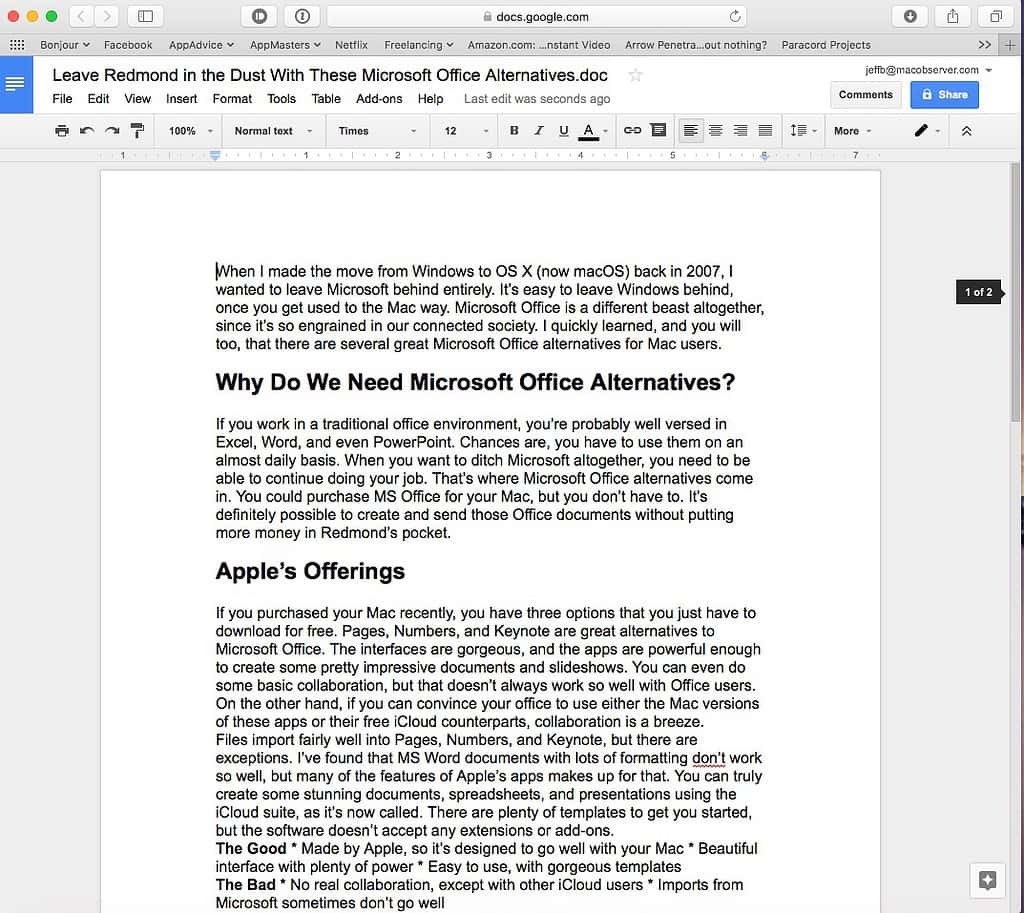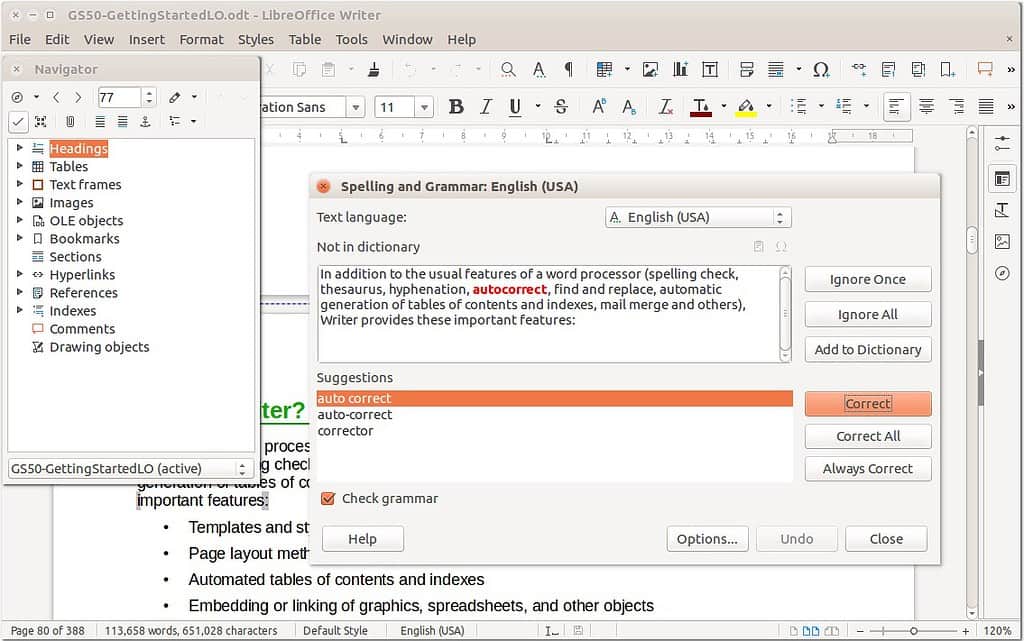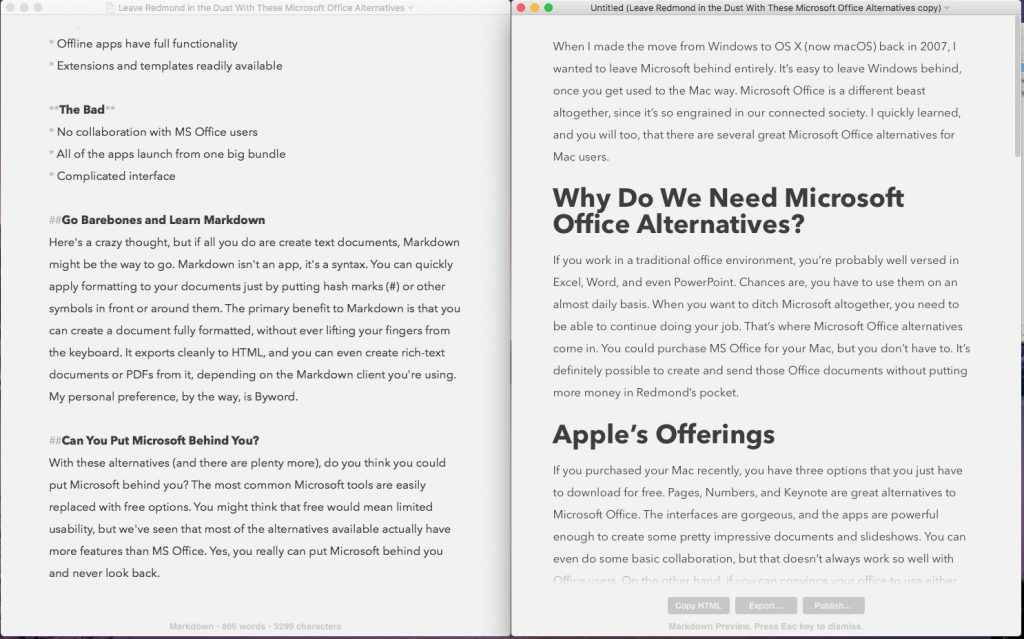Page 2 – Google Suite, LibreOffice, and Markdown
From One Giant to Another – Google Suite
If you don’t mind putting your eggs (and your data) in Google’s basket, the search giant has an amazing set of Office tools available for free. It integrates with any Google account, whether you have a Gmail address or your organization uses Google Apps. You can add and open office documents straight from the Gmail interface with just the press of a button.

When you receive Microsoft Word, Excel or PowerPoint files, they’re easy to import. Google has equivalent apps for each – Docs, Sheets, and Slides. The most common fonts and formatting choices are there. You also get an extensive add-on gallery with templates and other tools to make it even easier to create professional documents. The only “gotcha” here is that you have to be online to make the most of Google’s office suite.
The Good
* Fully compatible with Microsoft Office
* Creates gorgeous documents
* Easy collaboration
* Extensive add-on gallery
The Bad
* You’re potentially sacrificing your privacy to Google
* Most features rely on Internet connectivity
Stick With Open-Source and Use LibreOffice
If you’re used to Microsoft Office before the ribbon came about, you’ll feel right at home with LibreOffice. This software is a bit cumbersome at times, but once you get used to it, everything you need is right there. When you download LibreOffice, you get a full-featured offline suite of office applications. It’s compatible with Microsoft Word, Excel, PowerPoint, and even Publisher.

The apps within LibreOffice will open and edit any of Microsoft’s files, and you will have full control over your font and formatting choices. Even more features and document templates are available through LibreOffice’s dedicated websites.
The Good
* Fully compatible with MS Office
* Offline apps have full functionality
* Extensions and templates readily available
The Bad
* No collaboration with MS Office users
* All of the apps launch from one big bundle
* Complicated interface
Go Barebones and Learn Markdown
Here’s a crazy thought, but if all you do is create text documents, Markdown might be the way to go. Markdown isn’t an app, it’s a syntax. You can quickly apply formatting to your documents just by putting hash marks (#) or other symbols in front or around them. The primary benefit to Markdown is that you can create a document fully formatted, without ever lifting your fingers from the keyboard. It exports cleanly to HTML, and you can even create rich-text documents or PDFs from it, depending on the Markdown client you’re using. My personal preference, by the way, is Byword. With Byword, a free app with in-app purchases for more features, you can even export to Microsoft Word.

The Good
* Simple, but powerful
* Creates clean HTML and rich-text documents
* Formatting without lifting your fingers from the keyboard
The Bad
* Changing fonts within a document is difficult
* Requires learning the Markdown syntax
* Not as full-featured as other options
Can You Put Microsoft Behind You?
With these alternatives (and there are plenty more), do you think you could put Microsoft behind you? The most common Microsoft tools are easily replaced with free options. You might think that free would mean limited usability, but we’ve seen that most of the alternatives available actually have more features than MS Office. Yes, you really can put Microsoft behind you and never look back.

Like many others, I work in a multi-national organization where Office THE standard. And trying to use a different platform would only bring me massive headaches I don’t have time for (and consequences from executives) if I sent them ANYTHING that caused ANY format changes whatsoever.
Opting to not use Office is fine for those of you who are independent of a corporate structure, but please understand it is NOT an option for those of us that are.
Any by the way, I’m the only Mac user (marketing/advertising) in a Windows environment.
Christian_TTV
In answer to your question, it isn’t dogma. I’m very happy to be MS free on my Macs. I truly and utterly DESPISE the ribbon. I have to use MSOffice at work and I just hate it. IMO it’s the worst UI ever invented. I finally was able to load a secret copy of OpenOffice which I use as often as I can. The tools I never use are there in front of me and the tools I need are buried and nearly impossible to find. Yes I could spend a week trying to customize it to what I want. I tried that at work. The next update reset my ribbon to the stock one and I’d have to do it all over. The Ribbon was implemented because MS wanted to have a “new” interface. The trouble was that there was and is nothing wrong with the old one. Menus work great. The Ribbon just makes things harder to do.
But true not using MSOffice is nothing to be proud of. Saving money by being able to not buy overly expensive bloatware that doesn’t work as well is. Especially as I understand you can’t buy MSOffice for Mac any more. It’s part of Office365 which is a “Software as Service” for which you pay forever. Now I understand I’m lucky. I don’t have to share documents. I write them and then send them off or file them. Things might be different if I needed to collaborate on things.
If you need interoperability with MS Office documents, which if you work in the business world that is 90% PC/Office based is the case you need to use MS Office. As much as I’d like to see a true alternative to Office, the above mentioned solutions simply DO NOT WORK. I’ve tried them all and they will sooner or later fail miserably. They will either corrupt the MS document or will not correctly translate/interpret the formatting. Pages is an absolute joke of a substitute for MS Office. It can’t even handle simple Office documents and not screw them up. Just try any of these solutions with a >30 page document with auto paragraph numbering, auto page numbering, strict formatting rules, Table of Contents, Table of Figures, Change Bars, and headers & footers and see what happens. After modifying an Office doc with these alternates, try using Office on it again and see how well things worked. If your job depends on playing nice in the MS Office world, you need to use Office.
This article doesn’t answer the most important question: Why would it be advisable or desirable to ditch Microsoft Office? Only because it’s from Microsoft? This sounds like a dogma from an old millennium. There is nothing about a Microsoft free computer to be proud of. Let’s face it: Microsoft Office isn’t this bad. It’s actually quite capable and offers many features that are pretty unique on the Mac market. As a teacher, for example, I often add line numbering to my texts, so that students can refer precisely to certain quotes. Word is the only app that offers this in a modern and easy to use fashion. This is why I still use Word and don’t feel bad about it. I am sure there are quite a few features in Excel and PowerPoint that can’t be found in corresponding apps from the competition.
I’m proud to say my iMac is MS-Free. Haven’t had Office installed on my systems in at least a decade. Bounced between OpenOffice and more recently Pages. Had not heard that OO was discontinued. I have both OO and LibreOffice installed right now, but I haven’t used them as Pages seems to be working well.
I do agree with Scott about Collaboration. Of course for me collaboration is not an issue. I AM a writer. But even in the offices I’ve worked in they had rules and processes for editing a document, be it text or a spreadsheet. The first person would edit a document, then they saved it, then the next person edited it, and so on until it got final approval. Honestly I just can’t comprehend how it would work having a document with multiple people editing simultaneously. Why isn’t it chaos? What happens when three people want the same line to read three different ways? I honestly don’t understand how that could work.
@Scott- Have you tried Google Docs? I don’t know if Word offers this, but in Google, when I need multiple contributors to a document, I ask them to not edit directly, but to suggest edits. They go through, and all their edits need approval, and I can easily reject their suggestions. That is how I’ve done things to avoid utter chaos on my documents.
As to Mac word processing. If someone just needs that, I always recommend Nisus Writer. Either the Lite or Pro are great. It’s the one app I truly miss on Windows. There’s nothing else like it.
Collaboration is a red herring. IRL, I have never seen collaboration work properly… not that the software wouldn’t support it but the people muck things up. Many people marking up a document at the same time leads to chaos, especially technical documents. You really need a book boss and agreement on markup policies to make it effective. Unfortunately, collaboration tools do not support editing policies that would make this type of collaboration effective.
I really like OpenOffice, always rock solid, fast and painless., and free. I understand it’s discontinued but I didn’t even know that as I still use it all the time. I also have an old Office suite but I prefer the OpenOffice.